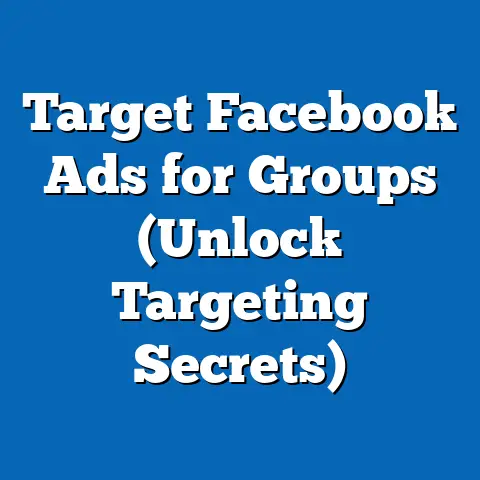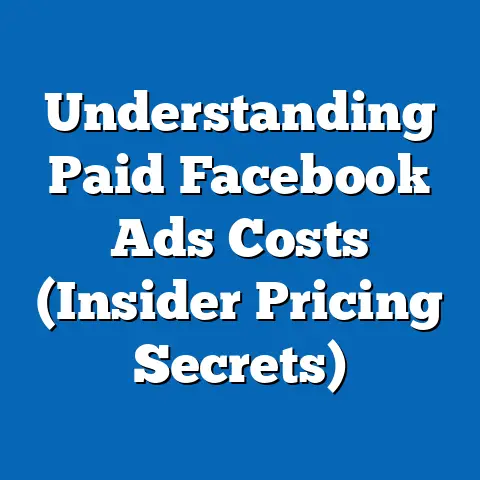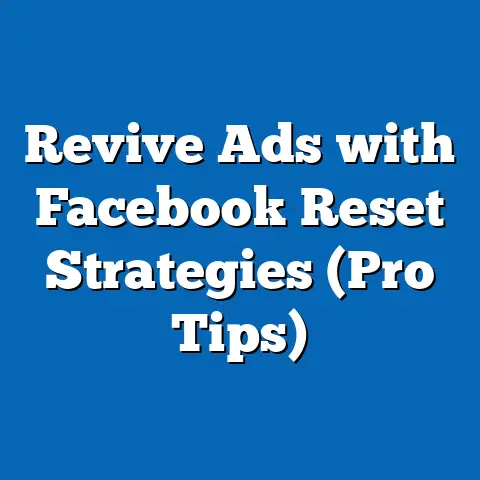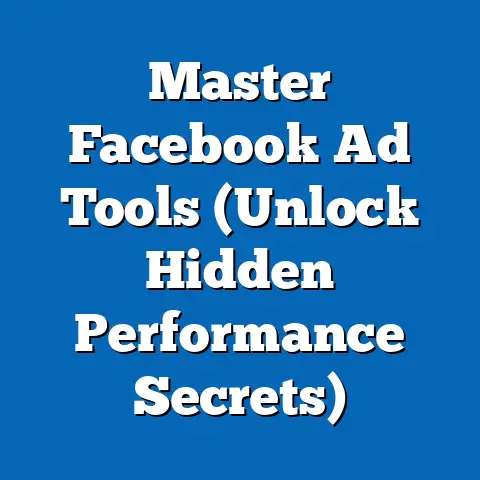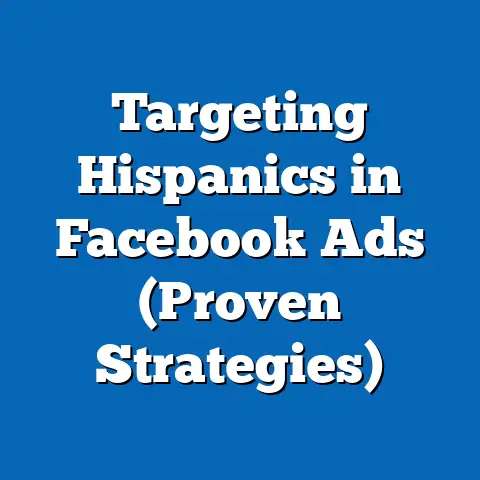Revamp Facebook Ads for Job Postings (Expert Strategies)
Imagine a bustling marketplace, vibrant and full of life. Each stall is vying for attention, trying to attract customers with enticing displays and irresistible offers. A successful stall isn’t just about having the best products; it’s about knowing how to present them, where to position them, and who to target. In the digital realm, Facebook ads are your stall in a marketplace teeming with billions of potential customers – or in this case, potential employees. If your job postings are lost in the digital noise, failing to attract the right talent, it’s time for a revamp.
This isn’t just another article about the basics of Facebook advertising. I’m going to dive deep, sharing the strategies that have consistently proven to be effective. We’ll explore everything from understanding the Facebook ads landscape to crafting the perfect job ad, targeting the right audience, optimizing your budget, and staying compliant with legal requirements. By the end of this guide, you’ll have the knowledge and tools you need to transform your Facebook ads into a powerful recruitment machine.
Understanding the Facebook Ads Landscape
Facebook has evolved far beyond a simple social networking site. Today, it’s a powerhouse advertising platform with unparalleled reach and sophisticated targeting capabilities. It’s no longer just about sharing vacation photos; it’s about connecting businesses with customers, and, increasingly, employers with potential employees.
Consider these statistics:
- As of 2023, Facebook boasts nearly 3 billion active monthly users (Source: Meta Investor Relations). This represents a massive pool of potential candidates, spanning diverse demographics and skill sets.
- The average Facebook user spends around 30 minutes per day on the platform (Source: Statista). This presents a significant opportunity to capture their attention with targeted job postings.
- Studies have shown that companies using social media for recruitment experience a 40% decrease in time-to-hire (Source: SHRM). Facebook, with its vast reach and engaging format, can significantly accelerate your hiring process.
But simply having a presence on Facebook isn’t enough. To truly leverage its power for job postings, you need to understand how the platform’s algorithm works. Facebook’s algorithm, at its core, aims to deliver the most relevant content to each user. This means that your job ads aren’t just competing with other job postings; they’re competing with cat videos, political rants, and everything in between.
How the Algorithm Works (and How to Make it Work for You):
- Relevance Score: Facebook assigns a relevance score to each ad based on how well it resonates with the target audience. Ads with higher relevance scores are favored by the algorithm and receive greater visibility. To boost your relevance score, focus on creating highly targeted ads that speak directly to the needs and interests of your ideal candidates.
- Engagement: The more users engage with your ad (likes, comments, shares, clicks), the more the algorithm will favor it. Encourage engagement by asking questions in your ad copy, using visually appealing images or videos, and offering valuable information.
- Bidding: Your bid determines how much you’re willing to pay for each click or impression. The higher your bid, the more likely your ad is to be shown to your target audience. However, simply throwing money at the problem isn’t the answer. The algorithm also considers your ad’s relevance score, so it’s crucial to optimize your ads for engagement.
Choosing the Right Ad Format:
Facebook offers a variety of ad formats, each with its own strengths and weaknesses. For job postings, some of the most effective formats include:
- Single Image Ads: These are simple and straightforward, allowing you to showcase your job posting with a single compelling image or graphic. This format is ideal for highlighting key benefits or showcasing your company culture.
- Video Ads: Video ads are highly engaging and can be used to tell a story, showcase your company culture, or provide a virtual tour of your workplace. This format is particularly effective for attracting younger candidates.
- Carousel Ads: Carousel ads allow you to showcase multiple images or videos in a single ad unit. This format is ideal for highlighting different aspects of the job, showcasing multiple team members, or providing a step-by-step guide to the application process.
- Collection Ads: Collection ads are designed to drive sales, but they can also be adapted for job postings. This format allows you to showcase a collection of related job openings, making it easy for candidates to browse and apply.
My Experience:
Early in my career, I was tasked with filling a challenging engineering role for a tech startup. We were struggling to attract qualified candidates through traditional job boards. Frustrated, I decided to experiment with Facebook ads. I created a video ad showcasing the company’s innovative culture and the exciting projects the engineers were working on. I targeted the ad to engineers with specific skills and interests. The results were astounding. Within a week, we received dozens of applications from highly qualified candidates. We ended up hiring an exceptional engineer who has been a valuable asset to the company ever since. This experience solidified my belief in the power of Facebook ads for recruitment.
Key Takeaway: Understanding the Facebook ads landscape is crucial for success. By understanding how the algorithm works and choosing the right ad format, you can significantly increase the visibility of your job postings and attract top talent.
Next Steps:
- Familiarize yourself with Facebook’s advertising policies and guidelines.
- Explore the different ad formats available and determine which ones are best suited for your job postings.
- Research your target audience and identify their interests, behaviors, and demographics.
Crafting the Perfect Job Ad
Now that you understand the Facebook ads landscape, let’s dive into the art of crafting the perfect job ad. A well-crafted job ad isn’t just about listing the job responsibilities and qualifications; it’s about telling a story, showcasing your company culture, and appealing to the aspirations of your ideal candidates.
Essential Components of a Successful Job Ad:
-
Compelling Headline: Your headline is the first thing candidates will see, so it needs to grab their attention and make them want to learn more. Use strong action verbs, highlight key benefits, and create a sense of urgency.
- Example: “Join Our Growing Team as a Software Engineer and Shape the Future of AI!”
-
Clear Job Description: Your job description should be clear, concise, and easy to understand. Avoid jargon and focus on the key responsibilities and qualifications. Be sure to highlight the benefits of working for your company, such as competitive salary, excellent benefits, and opportunities for growth.
-
Example: “As a Software Engineer, you will be responsible for developing and maintaining our cutting-edge AI platform. You will work alongside a team of talented engineers and contribute to the development of innovative solutions that are changing the world.”
-
Attractive Visuals: Your visuals should be eye-catching and relevant to the job posting. Use high-quality images or videos that showcase your company culture, your team, or your workplace.
-
Example: A photo of your team working collaboratively in a modern office space.
-
Strong Call-to-Action (CTA): Your CTA should tell candidates exactly what you want them to do. Use clear and concise language, such as “Apply Now,” “Learn More,” or “Join Our Team.”
-
Example: “Ready to join a dynamic and innovative team? Click here to apply now!”
Compelling Headline: Your headline is the first thing candidates will see, so it needs to grab their attention and make them want to learn more. Use strong action verbs, highlight key benefits, and create a sense of urgency.
- Example: “Join Our Growing Team as a Software Engineer and Shape the Future of AI!”
-
Clear Job Description: Your job description should be clear, concise, and easy to understand. Avoid jargon and focus on the key responsibilities and qualifications. Be sure to highlight the benefits of working for your company, such as competitive salary, excellent benefits, and opportunities for growth.
-
Example: “As a Software Engineer, you will be responsible for developing and maintaining our cutting-edge AI platform. You will work alongside a team of talented engineers and contribute to the development of innovative solutions that are changing the world.”
-
Attractive Visuals: Your visuals should be eye-catching and relevant to the job posting. Use high-quality images or videos that showcase your company culture, your team, or your workplace.
-
Example: A photo of your team working collaboratively in a modern office space.
-
Strong Call-to-Action (CTA): Your CTA should tell candidates exactly what you want them to do. Use clear and concise language, such as “Apply Now,” “Learn More,” or “Join Our Team.”
-
Example: “Ready to join a dynamic and innovative team? Click here to apply now!”
Clear Job Description: Your job description should be clear, concise, and easy to understand. Avoid jargon and focus on the key responsibilities and qualifications. Be sure to highlight the benefits of working for your company, such as competitive salary, excellent benefits, and opportunities for growth.
Example: “As a Software Engineer, you will be responsible for developing and maintaining our cutting-edge AI platform. You will work alongside a team of talented engineers and contribute to the development of innovative solutions that are changing the world.”
Attractive Visuals: Your visuals should be eye-catching and relevant to the job posting. Use high-quality images or videos that showcase your company culture, your team, or your workplace.
Example: A photo of your team working collaboratively in a modern office space.
Strong Call-to-Action (CTA): Your CTA should tell candidates exactly what you want them to do. Use clear and concise language, such as “Apply Now,” “Learn More,” or “Join Our Team.”
Example: “Ready to join a dynamic and innovative team? Click here to apply now!”
Creating Urgency:
Creating a sense of urgency can significantly increase the effectiveness of your job ads. Here are a few tactics you can use:
- Limited-Time Offer: “Apply within the next 7 days and receive a bonus!”
- Limited Number of Openings: “We’re hiring for a limited number of positions, so apply now!”
- Fast-Paced Environment: “Join our fast-paced and growing team!”
Examples of Well-Crafted Job Ads:
Let’s take a look at a few examples of job ads that have successfully attracted talent:
-
Example 1: Google – Software Engineer
- Headline: “Build the Future with Google: Software Engineer Opportunities”
- Visual: A photo of Google’s vibrant and collaborative workspace.
- Description: “Join our team of talented engineers and help us build innovative solutions that are changing the world. We offer competitive salaries, excellent benefits, and opportunities for growth.”
- CTA: “Apply Now”
-
Example 2: Airbnb – Customer Service Representative
-
Headline: “Join the Airbnb Team as a Customer Service Representative and Make a Difference”
- Visual: A photo of happy Airbnb employees providing excellent customer service.
- Description: “As a Customer Service Representative, you will be responsible for providing exceptional support to our guests and hosts. You will work in a fast-paced and dynamic environment and have the opportunity to make a real impact.”
- CTA: “Learn More”
Example 1: Google – Software Engineer
- Headline: “Build the Future with Google: Software Engineer Opportunities”
- Visual: A photo of Google’s vibrant and collaborative workspace.
- Description: “Join our team of talented engineers and help us build innovative solutions that are changing the world. We offer competitive salaries, excellent benefits, and opportunities for growth.”
- CTA: “Apply Now”
-
Example 2: Airbnb – Customer Service Representative
-
Headline: “Join the Airbnb Team as a Customer Service Representative and Make a Difference”
- Visual: A photo of happy Airbnb employees providing excellent customer service.
- Description: “As a Customer Service Representative, you will be responsible for providing exceptional support to our guests and hosts. You will work in a fast-paced and dynamic environment and have the opportunity to make a real impact.”
- CTA: “Learn More”
Example 2: Airbnb – Customer Service Representative
Headline: “Join the Airbnb Team as a Customer Service Representative and Make a Difference”
My Experience:
I once worked with a small non-profit organization that was struggling to find a development director. They had limited resources and were competing with larger, more established organizations. I helped them craft a Facebook ad that highlighted the organization’s mission and the impact the development director would have on the community. We used a compelling image of the people the organization served and a headline that spoke directly to the candidates’ passion for making a difference. The ad was a huge success. They received dozens of applications from highly qualified candidates who were passionate about the organization’s mission.
Key Takeaway: Crafting the perfect job ad is crucial for attracting top talent. By focusing on creating compelling headlines, clear job descriptions, attractive visuals, and strong CTAs, you can significantly increase the effectiveness of your Facebook ads.
Next Steps:
- Brainstorm compelling headlines that will grab the attention of your ideal candidates.
- Write clear and concise job descriptions that highlight the key responsibilities and qualifications.
- Choose high-quality images or videos that showcase your company culture and your team.
- Craft strong CTAs that tell candidates exactly what you want them to do.
Targeting the Right Audience
Creating a compelling job ad is only half the battle. To truly maximize the effectiveness of your Facebook ads, you need to target the right audience. Facebook offers a wide range of targeting options, allowing you to reach candidates based on their demographics, interests, behaviors, and custom audiences.
Facebook’s Targeting Options:
- Demographics: Target candidates based on their age, gender, education, location, and other demographic factors.
- Interests: Target candidates based on their interests, such as specific industries, hobbies, or professional organizations.
- Behaviors: Target candidates based on their behaviors, such as their purchase history, online activity, or travel habits.
- Custom Audiences: Create custom audiences based on your existing customer data, such as email lists or website visitors. This allows you to target candidates who are already familiar with your company.
- Lookalike Audiences: Create lookalike audiences based on your custom audiences. This allows you to target candidates who share similar characteristics and behaviors as your existing customers.
The Importance of Audience Segmentation:
Not all candidates are created equal. To maximize the effectiveness of your Facebook ads, you need to segment your audience and tailor your job ads for different target groups. For example, you might want to create separate ads for entry-level candidates and experienced professionals. You might also want to create separate ads for candidates with different skill sets or backgrounds.
Case Studies and Hypothetical Scenarios:
Let’s take a look at a few case studies and hypothetical scenarios showcasing effective targeting strategies:
-
Case Study 1: A Tech Company Hiring Software Engineers
- Target Audience: Software engineers with experience in specific programming languages (e.g., Python, Java, C++).
- Targeting Options: Demographics (age, location, education), Interests (software engineering, programming, artificial intelligence), Behaviors (online activity related to software development).
- Ad Copy: “Are you a skilled software engineer looking for a challenging and rewarding career? Join our team and help us build the future of AI!”
-
Hypothetical Scenario 1: A Restaurant Hiring Servers
-
Target Audience: Individuals with experience in the restaurant industry.
- Targeting Options: Demographics (age, location), Interests (restaurants, food, customer service), Behaviors (online activity related to dining and hospitality).
- Ad Copy: “Looking for a fun and rewarding career in the restaurant industry? Join our team and provide exceptional service to our guests!”
Case Study 1: A Tech Company Hiring Software Engineers
- Target Audience: Software engineers with experience in specific programming languages (e.g., Python, Java, C++).
- Targeting Options: Demographics (age, location, education), Interests (software engineering, programming, artificial intelligence), Behaviors (online activity related to software development).
- Ad Copy: “Are you a skilled software engineer looking for a challenging and rewarding career? Join our team and help us build the future of AI!”
-
Hypothetical Scenario 1: A Restaurant Hiring Servers
-
Target Audience: Individuals with experience in the restaurant industry.
- Targeting Options: Demographics (age, location), Interests (restaurants, food, customer service), Behaviors (online activity related to dining and hospitality).
- Ad Copy: “Looking for a fun and rewarding career in the restaurant industry? Join our team and provide exceptional service to our guests!”
Hypothetical Scenario 1: A Restaurant Hiring Servers
Target Audience: Individuals with experience in the restaurant industry.
My Experience:
I worked with a large hospital system that was struggling to fill nursing positions. They were competing with other hospitals in the area and were having trouble attracting qualified candidates. I helped them create a Facebook ad campaign that targeted nurses with specific specialties (e.g., ICU nurses, ER nurses, OR nurses). We created separate ads for each specialty, highlighting the unique benefits of working in that particular department. We also targeted the ads to nurses who had recently graduated from nursing school or who were looking to relocate to the area. The campaign was a huge success. They were able to fill all of their open nursing positions within a few months.
Key Takeaway: Targeting the right audience is crucial for maximizing the effectiveness of your Facebook ads. By understanding Facebook’s targeting options and segmenting your audience, you can reach the candidates who are most likely to be interested in your job postings.
Next Steps:
- Identify your ideal candidates and create detailed profiles of their demographics, interests, and behaviors.
- Segment your audience based on their skills, experience, and career aspirations.
- Experiment with different targeting options and track the results to see what works best.
Budgeting and Bidding Strategies
Now that you know how to craft the perfect job ad and target the right audience, let’s talk about budgeting and bidding strategies. Setting an appropriate budget and bidding strategy is crucial for maximizing your ROI and ensuring that your ads are seen by the right people.
Setting Ad Budgets:
There’s no one-size-fits-all answer to the question of how much you should spend on Facebook ads. Your budget will depend on a variety of factors, including:
- The size of your target audience: The larger your target audience, the more you’ll need to spend to reach them.
- The competitiveness of your industry: If you’re in a highly competitive industry, you’ll need to spend more to stand out from the crowd.
- Your desired results: If you’re looking to fill a large number of positions quickly, you’ll need to spend more than if you’re just looking to fill a few positions over a longer period of time.
Bidding Strategies:
Facebook offers a variety of bidding strategies, each with its own advantages and disadvantages. Some of the most common bidding strategies include:
- Cost-Per-Click (CPC): You pay each time someone clicks on your ad. This strategy is ideal if you’re looking to drive traffic to your website or landing page.
- Cost-Per-Impression (CPM): You pay for every 1,000 impressions of your ad. This strategy is ideal if you’re looking to increase brand awareness or reach a large audience.
- Cost-Per-Acquisition (CPA): You pay each time someone takes a desired action, such as applying for a job. This strategy is ideal if you’re looking to maximize your ROI.
A/B Testing:
A/B testing is the process of testing different variations of your ads to see which ones perform best. This is a crucial step in optimizing your budget and bidding strategies. You should A/B test everything from your headlines and ad copy to your visuals and targeting options.
Analyzing Ad Performance Metrics:
To optimize your budget and bidding strategies, you need to track your ad performance metrics. Some of the most important metrics to track include:
- Impressions: The number of times your ad has been shown.
- Clicks: The number of times people have clicked on your ad.
- Click-Through Rate (CTR): The percentage of people who have seen your ad and clicked on it.
- Cost-Per-Click (CPC): The average cost of each click on your ad.
- Cost-Per-Acquisition (CPA): The average cost of each desired action, such as an application.
- Conversion Rate: The percentage of people who have clicked on your ad and taken a desired action.
My Experience:
I once worked with a startup that had a limited budget for Facebook ads. They were unsure how much to spend and which bidding strategy to use. I recommended that they start with a small budget and use the CPC bidding strategy. We then A/B tested different variations of their ads to see which ones performed best. We tracked their ad performance metrics closely and adjusted their budget and bidding strategy accordingly. Over time, we were able to significantly improve their ROI and attract a large number of qualified candidates.
Key Takeaway: Setting an appropriate budget and bidding strategy is crucial for maximizing your ROI. By A/B testing different variations of your ads and tracking your ad performance metrics, you can optimize your budget and bidding strategy over time.
Next Steps:
- Determine your budget based on the size of your target audience, the competitiveness of your industry, and your desired results.
- Choose a bidding strategy that aligns with your goals and budget.
- A/B test different variations of your ads to see which ones perform best.
- Track your ad performance metrics closely and adjust your budget and bidding strategy accordingly.
Creative Strategies for Job Postings
Beyond the fundamentals of crafting compelling ads and targeting the right audience, there are creative strategies you can employ to make your job postings stand out and resonate with potential candidates.
Incorporating Employee Testimonials:
Authentic employee testimonials can be incredibly powerful in attracting talent. Sharing real experiences from your current employees can provide potential candidates with valuable insights into your company culture and the day-to-day realities of working at your organization.
- Example: Feature a short video testimonial from an employee discussing their career growth opportunities within the company.
- Example: Include a quote from an employee about the supportive and collaborative work environment.
Behind-the-Scenes Videos:
Giving potential candidates a glimpse behind the scenes of your company can help them visualize themselves working there and build a connection with your organization.
- Example: Create a video showcasing a typical day in the life of an employee in the role you’re hiring for.
- Example: Offer a virtual tour of your office space, highlighting the amenities and collaborative areas.
Interactive Content:
Interactive content can be a great way to engage potential candidates and make your job postings more memorable.
- Example: Create a quiz that helps candidates determine if they’re a good fit for the role.
- Example: Host a poll asking candidates what they value most in a job.
Retargeting Ads:
Retargeting ads allow you to re-engage users who have shown interest in your job postings but haven’t yet applied.
- Example: Show retargeting ads to users who have visited your careers page or viewed your job postings on Facebook.
- Example: Offer a special incentive to users who have shown interest but haven’t yet applied, such as a guaranteed interview.
Facebook Live Sessions and Q&A Formats:
Hosting Facebook Live sessions or Q&A formats can be a great way to connect with potential candidates in real-time and answer their questions about your company and the role you’re hiring for.
- Example: Host a Facebook Live session with your hiring manager to answer questions about the job requirements and the team culture.
- Example: Host a Q&A session with current employees to provide potential candidates with insights into the company’s values and work environment.
My Experience:
I once worked with a company that was struggling to attract millennial candidates. We decided to experiment with Facebook Live sessions. We hosted a live Q&A session with the company’s CEO and a panel of millennial employees. The session was a huge success. We received hundreds of questions from potential candidates and the CEO and employees were able to answer them in a candid and engaging way. The session helped to humanize the company and make it more appealing to millennial candidates.
Key Takeaway: Employing creative strategies can help you make your job postings more engaging and memorable. By incorporating employee testimonials, behind-the-scenes videos, interactive content, retargeting ads, and Facebook Live sessions, you can significantly increase your chances of attracting top talent.
Next Steps:
- Brainstorm creative ideas for making your job postings more engaging.
- Experiment with different formats and approaches to see what works best for your target audience.
- Track your results and adjust your strategies accordingly.
Compliance and Best Practices
While it’s important to be creative and engaging with your job postings, it’s also crucial to be mindful of legal considerations and best practices. Failing to comply with anti-discrimination laws or engaging in unprofessional behavior can damage your company’s reputation and lead to legal repercussions.
Legal Considerations:
- Anti-Discrimination Laws: Be aware of anti-discrimination laws that prohibit discrimination based on race, color, religion, sex, national origin, age, disability, or genetic information. Avoid using language or images that could be interpreted as discriminatory.
- Equal Employment Opportunity (EEO): Ensure that your job postings comply with EEO guidelines. This includes providing equal opportunities to all applicants, regardless of their background or characteristics.
- Transparency: Be transparent about the job requirements, responsibilities, and compensation. Avoid misleading or deceptive language.
Best Practices:
- Maintain Professionalism: Use professional language and images in your job postings. Avoid slang, jargon, or inappropriate content.
- Be Authentic: Be authentic and genuine in your communication. Don’t try to be something you’re not.
- Showcase Company Culture: Highlight your company culture and values in your job postings. This will help attract candidates who are a good fit for your organization.
- Provide a Clear Company Culture: Be transparent about your company culture and values. This will help candidates make informed decisions about whether or not to apply.
- Respond to Inquiries: Respond to inquiries from potential candidates in a timely and professional manner. This shows that you value their interest and are committed to providing a positive candidate experience.
My Experience:
I once worked with a company that inadvertently violated anti-discrimination laws in their job postings. They were using language that could be interpreted as favoring younger candidates. I advised them to revise their job postings to remove any potentially discriminatory language. I also recommended that they provide training to their hiring managers on anti-discrimination laws and best practices.
Key Takeaway: It’s crucial to be mindful of legal considerations and best practices when creating job postings on Facebook. By complying with anti-discrimination laws, maintaining professionalism, and showcasing your company culture, you can attract top talent and avoid legal repercussions.
Next Steps:
- Familiarize yourself with anti-discrimination laws and EEO guidelines.
- Review your existing job postings to ensure that they comply with legal requirements.
- Provide training to your hiring managers on anti-discrimination laws and best practices.
Conclusion
Revamping your Facebook ads for job postings requires a strategic and multifaceted approach. It’s not just about throwing money at ads; it’s about understanding the Facebook ads landscape, crafting the perfect job ad, targeting the right audience, optimizing your budget, employing creative strategies, and staying compliant with legal requirements.
By following the strategies outlined in this guide, you can transform your Facebook ads into a powerful recruitment machine that attracts top talent and helps you build a high-performing team. Remember, your job postings are a reflection of your company. Make sure they are compelling, engaging, and representative of your company culture and values.
Facebook ads can be a powerful tool in your recruitment arsenal. By taking the time to understand the platform, craft compelling ads, and target the right audience, you can significantly improve your chances of attracting top talent. So, go ahead and take action on the strategies discussed in this guide. I’m confident that you’ll see positive results.
I know firsthand that success with Facebook ads doesn’t happen overnight. It takes consistent effort, experimentation, and a willingness to adapt to changing trends. But with the right approach, you can unlock the full potential of Facebook advertising and build a team that’s ready to tackle any challenge.
Call to Action:
I’d love to hear about your experiences with Facebook job ads. What strategies have you found to be most successful? What challenges have you faced? Share your thoughts and insights in the comments below. Let’s learn from each other and build a community of Facebook advertising experts!

